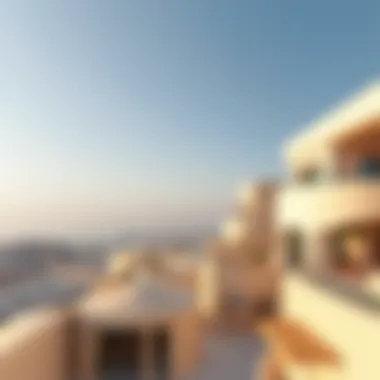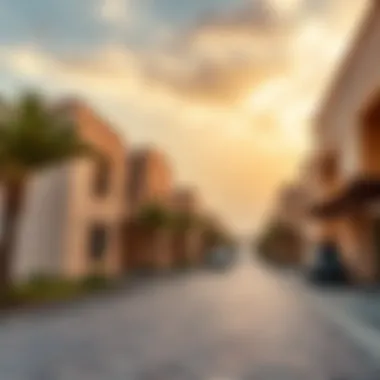Analyzing OIA Properties in Dubai: Trends and Insights


Intro
The real estate landscape in Dubai has been evolving rapidly, making it a hotbed for investors and homeowners alike. Among various property types, OIA properties stand out due to their unique features and potential for reasonable returns. This article will peel back the layers of the OIA property sector, focusing on key trends, investment tips, and factors that make these properties attractive for various stakeholders.
Dubai, with its vibrant culture and booming economy, presents an excellent opportunity for those seeking to invest in real estate. However, navigating the intricacies of the market requires more than just enthusiasm; a thorough understanding of OIA properties and how they fit into the broader market is essential.
As we dive into this analysis, expect to gather insights that will empower you as an investor, buyer, or agent. Join us on this informative journey to formulate intelligent decisions in the Dubai property market.
Property Market Analysis
Current Market Trends
In the world of OIA properties, trends can shift as quickly as the desert wind. Notably, demand has surged for luxury villas and high-rise apartments, as buyers are chasing not just homes, but lifestyle enhancements. Factors like government initiatives and events like Expo 2020 have sparked unprecedented interest in the Dubai real estate sector. Investors are looking for properties that promise not just comfort but also potential capital appreciation.
- Luxury Segment Growth: As the global elite continue to invest in properties in Dubai, high-end segments have seen an uptick in activity. Developments in areas like Palm Jumeirah are particularly favorable.
- Sustainable Developments: With an increasing emphasis on eco-friendly designs, properties that incorporate sustainable building practices are becoming increasingly desirable. Buyers are now more inclined to invest in properties that not only showcase architecture but also contribute positively to the environment.
Price Fluctuations and Insights
Understanding the nuances of price fluctuations is critical when evaluating OIA properties. Prices in Dubai real estate can experience movements based on a variety of factors, such as global economic conditions or local legislative changes. In recent years, some notable trends have emerged:
- Market Correction: After a period of rapid growth, some areas witnessed a price correction, leading to more attractive entry points for investors.
- Rental Returns: While fluctuations are a common feature of real estate markets, OIA properties have consistently performed well in rental markets, offering returns that often surpass those in other major global cities. The combination of tourist attractions and a robust expatriate community fuels rental demand.
"Investors need to keep their ears to the ground, as market dynamics in Dubai can shift like sand with the desert wind."
Investment Opportunities
Key Areas for Property Investment
For those looking to tap into the OIA property market in Dubai, certain areas offer distinct advantages.
- Downtown Dubai: Home to the iconic Burj Khalifa and The Dubai Mall, this area promises a blend of luxury and accessibility, positioning it as a prime investment hotspot.
- Dubai Marina: Known for its high-rise buildings and scenic waterfront views, this area attracts both tenants and buyers looking for an urban lifestyle.
- Jumeirah Beach Residence: Popular among tourists and residents, this location boasts beaches, shopping, and a vibrant nightlife, making it a goldmine for rental properties.
Tips for First-Time Investors
Investment in OIA properties can be daunting for newcomers, but with the right advice, it can also be rewarding:
- Do Your Homework: Familiarize yourself with the market. Understand the different property types, their locations, and the market dynamics.
- Consider Financing Options: Explore various financing routes available for purchasing properties in Dubai.
- Engage Professionals: Partnering with experienced real estate agents can provide valuable insights and assistance in navigating the market.
- Assess Market Timing: Invest when market conditions are favorable, which may involve waiting for inevitable corrections.
- Plan for the Long-Term: Real estate is usually a long-term investment. Be prepared for fluctuations and keep a ten-year perspective in mind.
By following these recommendations, first-time investors can mitigate risks and position themselves for potential rewards in the competitive OIA property market.
As we explore further, the upcoming sections will delve into architectural innovations and investment strategies that promise to enhance your understanding and decision-making process in the Dubai real estate sector. Stay tuned!
Preamble to OIA Properties
Diving into the world of OIA properties in Dubai is not just about assessing market value or snapping up real estate. There's a whole universe of intricacies that deserve a closer look. With Dubai’s skyline constantly morphing, understanding OIA properties—themselves—turns out to be vital for any potential buyer or investor.
Considering the burgeoning demand, OIA properties stand out for their ability to blend luxury with investment potential. For investors, these properties are not just assets, but also gateways into Dubai’s diverse lifestyle and culture. The term OIA, or Owner-Occupied Investment Properties, indicates a certain standard and quality. Buyers can expect more than just a place to live; they’re investing in an experience.
A key element in this realm is understanding how these properties are sold, rented, or lived in by owners versus investors. For instance, many buyers intend to occupy these spaces while also seeing them as potential revenue sources through rental arrangements. What this means for the savvy investor is an opportunity not just to have a roof over their heads, but also to generate income—a two-for-one deal if you will!
Additionally, it is essential to consider the regulations surrounding OIA properties. Dubai's real estate laws can be intricate and varied, requiring keen awareness from all involved parties. Buyers need to know their rights and responsibilities, as the last thing anyone wants is a nasty surprise coming down the road. If you're planning to dip your toes into this market, awareness about these factors aids in informed decision-making.
Navigating through the OIA scene mandates not just knowledge but also adaptability to shifting market dynamics. Prices fluctuate, and regional regulations change—understanding these shifts is imperative. Keeping abreast of local news and developments can be as valuable as the properties themselves. The insights derived will assist potential buyers and investors in making well-informed choices that resonate with their financial goals.
"Investing in OIA properties isn’t merely a transactional affair; it’s akin to planting seeds for a future blossoming with opportunities."
As you continue through this article, you will uncover a variety of layers within the context of OIA properties in Dubai. From the historical background to current investment trends and more, the analytical perspective outlined will better equip you for success in your property endeavors.
Defining OIA Properties
When it comes to defining OIA properties, it’s crucial to recognize what separates them from standard real estate. Owner-Occupied Investment Properties are places where the owner intends to live while also having the option to lease it out. This dual-purpose nature makes them particularly appealing for a range of buyers—from expatriates to local residents looking for a smart financial move.
Typically, these properties can be condos, townhouses, or villas, with locations often tapping into Dubai's finest neighborhoods. These spots are usually close to major amenities, work hubs, and social hotspots—making them even more attractive. The potential for capital appreciation can be significant, amplified by the vibrant market and continuous influx of residents from across the globe.
A recent trend has shown that buyers often look for high-quality finishes and modern facilities—think swimming pools, gymnasiums, and landscaped gardens. Buyers aren’t just looking for a house; they’re buying a lifestyle.
Historical Context of OIA Properties in Dubai
To understand the present landscape of OIA properties, it’s essential to consider their evolution. Dubai's real estate market, unlike many others, has undergone massive transformations over the years, largely due to economic shifts and government development strategies.
In the early 2000s, Dubai's real estate sector started gaining traction, heavily influencing the emergence of OIA properties. As the populace burgeoned along with the economy, so did the demand for varied housing options. Key development projects like the Palm Jumeirah and Downtown Dubai shifted perspectives on luxury living, highlighting not just the aesthetics but also the property investment potential. Investors began to understand the value of luxury residences that doubled as viable income sources.
As time moved along, regulatory frameworks began to take shape, providing a safety net for both tenants and landlords, paving the way for a more structured market. This historical context contributes immensely to current value perceptions, and savvy investors often draw on past lessons to navigate the present.
Each of these layers creates a distinct profile of what OIA properties represent in Dubai today—making them a critical focus for anyone involved or interested in the city's dynamic real estate market.


Market Overview
Understanding the market dynamics of OIA properties in Dubai is not merely an academic exercise; it’s crucial for potential buyers and investors. The real estate landscape in this vibrant city is ever-evolving, and being attuned to market movements can make a significant difference in making informed decisions. Key elements such as current trends and the global economic environment shape the buying landscape, impacting everything from price points to investment strategies. This overview serves as a foundational guide, providing insights that are essential as one navigates through the complexities of the Dubai real estate market.
Current Trends in the Dubai Real Estate Market
The Dubai real estate market is like a roller coaster; it has its ups and downs, but the view from the top can be outstanding. In recent years, several trends have emerged, shaping the way transactions occur and properties are valued. One notable trend is an increased demand for OIA properties, fueled by international interest. Buyers are more inclined to invest in real estate that offers not just good returns but also a lifestyle, leading to bustling activity in areas boasting appealing amenities and accessibility.
The residential market, for example, has shown a robust appetite for properties that provide a seamless blend of luxury and practicality. Properties equipped with features like smart home technology and sustainable designs have seen a notable uptick in interest. Moreover, state-of-the-art amenities, such as gyms and pools, are becoming non-negotiables for many buyers.
Additionally, the commercial real estate sector is witnessing a shift. With recent global trends encouraging remote work, there has been a pivot towards flexible office spaces and properties that cater to diverse work environments.
"Investors and buyers are not just searching for spaces; they are looking for experiences."
This changing consumer behavior necessitates a keen understanding of what drives demand and how properties can adapt to meet evolving expectations.
Impact of Global Economic Conditions
The broader global economic landscape plays a critical role in shaping Dubai's real estate market. Economic indicators, such as interest rates, inflation, and geopolitical stability, have direct implications on investment patterns. For instance, a hike in interest rates can dampen buyer enthusiasm, leading to decreased purchasing power. Conversely, when borrowing is cheaper, many potential buyers seize the opportunity, flooding the market.
Additionally, global events—like pandemics or financial crises—can cause ripples that affect confidence in investing. The ongoing dialogue surrounding sustainability and environmental impact also finds its way into investment decisions. Investors are increasingly leaning towards properties that are not only lucrative but also environmentally responsible.
Furthermore, the UAE government has created policies to attract foreign investors, ensuring a conducive environment for property purchases. These policies, alongside favorable economic conditions, can result in a buoyant real estate market that continues to thrive despite global uncertainties.
Diversity of OIA Properties in Dubai
The landscape of OIA properties in Dubai is as varied as its towering skyscrapers. Understanding this diversity is crucial for potential investors and buyers looking to make a mark. The multifaceted nature of OIA properties extends beyond mere classification. It encompasses residential havens, commercial enterprises, and opulent developments, each presenting unique advantages and challenges.
Residential OIA Properties
Residential OIA properties are designed to cater to a wide range of lifestyles and preferences. From sleek, modern apartments in downtown Dubai to spacious villas in quieter districts, the options are abundant. These properties often feature amenities like swimming pools, gyms, and in some cases, breathtaking views of the Arabian Gulf.
Investors find residential properties particularly appealing due to their high rental yields and potential for appreciation. Properties in prime locations like Dubai Marina and Downtown Dubai tend to attract a steady influx of expatriates and locals, ensuring strong demand.
A key consideration when investing in residential OIA properties is the understanding of community regulations and the diverse demographics residing in these areas. Each neighborhood presents its own charm and character, making it essential for buyers to align their investment with their lifestyle or target market.
Commercial OIA Properties
Turning the spotlight to commercial OIA properties reveals another critical aspect of Dubai's real estate landscape. These properties cater to businesses, ranging from retail spaces in bustling malls to expansive offices in likened to Silicon Oasis. The commercial real estate market in Dubai has seen remarkable growth, partly driven by ongoing economic diversification efforts and an influx of multinational companies.
Commercial properties typically demand a deeper understanding of market trends and the socio-economic factors influencing business viability. For instance, the rise in e-commerce has altered retail landscapes, while demand for coworking spaces has surged, especially among startups and freelancers. Navigating this dynamic environment necessitates a keen eye for location, accessibility, and potential return on investment.
Luxury and High-End Developments
When it comes to luxury and high-end developments, Dubai sets a gold standard. Properties like the Burj Khalifa and Palm Jumeirah not only signify opulence but also represent a lifestyle choice for affluent buyers. These developments are often equipped with world-class facilities, providing a unique living experience that goes beyond just a home.
Investors in the luxury segment often look for exclusivity and prestige. High-end developments tend to show resilience in value retention, even during economic downturns. However, potential buyers should be aware of the market's cyclical nature and the importance of location, as some luxury properties may face supply challenges as new developments spring up.
In summary, the diversity of OIA properties in Dubai presents a wealth of opportunities for investors and buyers alike. With the right insights and understanding of market dynamics, stakeholders can make informed decisions that align with their investment goals and lifestyle choices.
Investment Opportunities
Investment opportunities in OIA properties play a pivotal role for potential buyers and seasoned investors alike. With the Dubai real estate market constantly evolving, understanding where to put your money can significantly impact your returns. This aspect is not just about financial growth; it’s about aligning investments with the strategic objectives set in an ever-dynamic landscape. Several key factors come into focus when discussing investment opportunities.
First, there's the predictability of the market. The consistency evident in Dubai's growth, especially in key districts, suggests that investments here come with a semblance of stability. The location of OIA properties often makes them quite appealing, given their potential for appreciation.
Moreover, the diversification of investment portfolios in this sector can lead to lower risks. By exploring various types of properties, from commercial spaces to high-end residential units, an investor can safeguard against downturns in any one sector. The demand for luxury and well-placed properties remains potent, particularly among both expatriates and the local populace.
Furthermore, investors should consider the flow of foreign capital into Dubai. Policies aimed at attracting foreign investment, like long-term visas for property buyers, enhance the desirability of OIA properties. This adds to the appeal for those looking to invest, as it creates a scenario that often drives property values up.
In sum, evaluating these investment opportunities calls for thorough research and an astute understanding of market dynamics. Now, let’s dig deeper into the specifics of identifying lucrative investment areas within the OIA properties market.
Identifying Lucrative Investment Areas
When it comes to pinpointing lucrative investment areas in Dubai’s OIA properties, the task can seem daunting at first. However, a strategic methodology helps streamline this process. Key areas are characterized not just by the property itself but also by the surrounding amenities and projected growth.
- Market Trends: Tracking existing market trends provides insight into which areas are on the rise. Areas like Dubai Marina and Downtown Dubai consistently attract attention due to their developments and lifestyle offerings.
- Infrastructure Development: New transportation links, such as the Dubai Metro expansions, play a crucial role. Regions that are set to benefit from improved connectivity often see substantial rise in property values. For instance, properties near the Expo 2020 site are witnessing heightened interest as the area continues to evolve post-event.
- Economic Indicators: Keep an eye on economic reports and investor sentiments. A fluctuating economy often leads to trends in real estate that can signal a good time to invest in certain locations. Notably, regions projected for commercial development often experience increased residential demand.
- Community Assessment: Evaluating the community can provide insiders' perspectives. Areas known for family-friendly amenities, schools, and healthcare facilities tend to attract a stable demographic, which is advantageous for long-term investments.
A comprehensive investigation into these elements can illuminate paths toward potentially profitable investments in OIA properties.
Long-Term vs. Short-Term Investments
Investors face a critical decision when it comes to time horizons in their investment strategies - whether to pursue long-term or short-term investments. Each approach carries its perks and pitfalls, and understanding these nuances is key for optimizing one’s engagement with OIA properties.
Long-term investments generally promise stability and consistent revenue streams through rental income. This approach is particularly favorable in bustling areas with a high demand for rentals:
- Property Appreciation: Over time, properties tend to appreciate in value. Investors get to reap the benefits when they sell their holdings later.
- Steady Cash Flow: Rental properties generate continuous income. The longer you hold these assets, the better they may serve as reliable cash flow streams.


However, patience is required, and the upfront commitment can be more significant.
On the other hand, short-term investments — often involving buying, refurbishing, and selling properties quickly— can offer rapid returns:
- Quick Gains: Investors can realize profits quickly, particularly if market conditions are favorable and properties are located in high-demand districts.
- Flexibility: Short-term strategies allow investors to exit the market quickly and adapt to changing market conditions.
Yet, this approach carries risks as market fluctuations may hinder immediate profit-generation.
Ultimately, the decision hinges on your investment philosophy, risk appetite, and market conditions. Either way, approaching investments with a clear strategy tailored to current and future market environments will enhance success in Dubai's property scene.
Architectural Innovations in OIA Properties
Architectural innovations within OIA properties in Dubai aren't just about aesthetics or having the flashiest buildings on the block. There’s a deeper significance behind these advancements, influencing how spaces are utilized and perceived. With Dubai designed to be a global hub, the architectural landscape continues to evolve, showcasing progressive design practices that cater to both functionality and sustainability. The crux of architectural innovation lies in its ability to adapt to the dynamic demands of the market, making it an essential pillar in the evaluation and investment in OIA properties.
These innovations create a symbiotic relationship with the environment, increasing value for investors and enhancing the living experience for residents. As global attention turns to sustainable measures, properties that incorporate groundbreaking architectural elements can not only attract buyers but also command higher prices in competitive markets.
Sustainable Design Practices
Sustainable design practices in OIA properties can fundamentally change how buildings interact with their surroundings. Think of them as a breath of fresh air in the steel-and-glass jungle that characterizes Dubai's skyline. Utilizing materials like recycled components along with energy-efficient technologies minimizes environmental impact. Such considerations go beyond mere compliance; they are becoming a standard expectation among buyers.
For instance, the implementation of green roofs may seem like a fad, yet they help reduce heating and cooling costs while contributing to local biodiversity. Plus, many developers are opting for smart materials that can adapt to environmental changes. This foresight not only aligns with global sustainability goals but also appeals to a more conscientious buyer base.
"The future of architectural design is not just in creating structures, but in building relationships with nature." – Unknown
Additionally, methods like rainwater harvesting and solar panel utilization are now being integrated into many new constructions. Hence, properties designed with a focus on sustainability further develop a positive reputation, which can be crucial in securing long-term investments.
Smart Home Technology Integration
In the age of technology, integrating smart home solutions within OIA properties is quickly becoming the norm rather than the exception. This shift not only caters to the tech-savvy clientele but also enhances the day-to-day living experience. From automated lighting systems to advanced security measures, these innovations offer convenience as well as safety.
Imagine controlling your entire home environment with just a smartphone or voice command. This level of interactivity adds an appealing layer of comfort for potential buyers. Furthermore, home automation allows for effective energy management, which can lead to significant cost savings over time. In Dubai’s fierce climate, air conditioning smart controls can play a vital role in reducing utility bills.
Moreover, the addition of features like smart thermostats and integrated smart entertainment systems attract a demographic that prioritizes quality living. With options for customizability, buyers can tailor their living spaces to their preferences, adding a personal touch that traditional properties struggle to offer.
While architectural innovations in OIA properties like sustainable design practices and smart home technology integration focus on creating a holistic living environment, they also reflect broader market trends and buyer expectations.
Accompanied by a rigorous appraisal process and clear understanding of property values, they empower investors and homeowners to make informed decisions, not just for today but for years to come.
Assessing Property Value
Assessing the value of OIA properties in Dubai isn’t just a matter of slapping a price tag on a place. It’s a complex process that requires careful consideration of numerous factors, both intrinsic and extrinsic. Understanding the nuances around property valuation helps potential buyers and investors make informed choices, ensuring their financial stakes are well-protected. A comprehensive assessment can mean the difference between striking it rich in the real estate market and catching a cold from a poor investment.
Factors Influencing Property Prices
When it comes to property prices, a myriad of factors play into the final numbers. Here’s a closer look:
- Location: You’ve heard the mantra "location, location, location." It holds water because properties in well-established neighborhoods or those with easy access to major roads and public transport will often command higher prices.
- Market Demand: In a city like Dubai, with its fluctuating economies, demand can sway prices significantly. When there’s a high demand among buyers, especially for OIA properties, the prices tend to ascend.
- Property Type and Condition: A luxurious penthouse is automatically going to fetch more than a standard apartment simply because of its type. The condition of the property comes into play too; a well-maintained building will be valued competitively compared to its rundown counterparts.
- Amenities: If the property offers unique amenities like pools, security services, or proximity to leisure facilities such as parks and shopping areas, it gives it a competitive edge.
These factors shape a property's perceived and actual value, playing a crucial role for anyone thinking about diving into the Dubai market.
Understanding Market Appraisals
Market appraisals are like the litmus tests in real estate. They gauge the value of a property based on the current market conditions, comparable property sales, and an evaluation of the property itself. This is how it unfolds:
- Comparative Analysis: Appraisers often look at recent sales of similar properties in the area (or the dreaded "comps" as the insiders call them). If the average sale price of similar properties is on the rise, it could positively influence the valuation of OIA properties.
- Professional Insights: Relying on an experienced appraiser can shed crucial light on the market trends. Their assessment can provide valuable information about how a property stacks up against others in its vicinity.
- Regulatory Standards: Appraisals must conform to the standards set by regulatory bodies. This helps ensure there’s integrity in the valuations used in transactions.
In essence, accurate appraisals form the backbone of prudent property investment. They help assess risks and forecast realistic returns.
In wrapping up this segment, it becomes glaringly apparent that proper assessment of property values is pivotal in the Dubai real estate landscape. By honing in on the key elements influencing prices and understanding the appraisal mechanism, investors and buyers can navigate the market with greater assurance and clarity.
Navigating the Purchasing Process
Navigating the purchasing process of OIA properties in Dubai is essential for buyers and investors. This stage forms the foundation on which successful acquisitions hinge. Given the dynamic nature of the Dubai real estate market, understanding the steps involved ensures that buyers make informed decisions, thereby mitigating risks associated with property investment. It's not just about buying a property; it's about finding value amidst the myriad of options available.
Key Steps in Buying OIA Properties
When looking to purchase an OIA property, several key steps should guide the process:
- Research and Identify Preferences
Understanding personal requirements such as location, size, and amenities is crucial. Researching neighborhoods and property types can save time and effort in the long run. - Engage with a Qualified Real Estate Agent
Partnering with an experienced real estate agent can provide insights into available properties and market trends. They can help streamline the process, guiding you through the maze of listings. - Arrange Financing
Before putting pen to paper, it is vital to explore financing options. Having your finances in order - whether through savings or mortgage options - makes offers more attractive and positions you favorably with sellers. - Conduct Property Viewings
Physical inspections of properties allow buyers to assess the condition and suitability of the property. This step is invaluable for ensuring the property matches expectations. - Make an Offer
Once a suitable property has been identified, framing a compelling offer is key. Factors like market conditions and comparative property prices play into this decision. - Negotiate Terms
Be prepared for negotiations post-offer. Whether it’s the price, inclusions, or timelines, clear and open communication can lead to favorable agreements for both parties. - Conduct Due Diligence
Before sealing the deal, performing due diligence is vital. This includes title deed checks, verifying property boundaries, and evaluating any liabilities or restrictions. - Finalize the Purchase Agreement
Once all terms are agreed upon, the purchase agreement should be meticulously reviewed and finalized. This document lays out all conditions tied to the sale. - Complete Payment and Transfer of Ownership
After everything's been agreed upon, making the final payment and officially transferring ownership marks the culmination of the process.
Understanding these steps can remove confusion and provide clarity as buyers venture into Dubai’s real estate market.
Legal Considerations and Regulatory Framework
Legal considerations are paramount when it comes to purchasing OIA properties. Dubai’s property laws can be intricate, and ensuring compliance is non-negotiable. A few noteworthy aspects include:


- Freehold vs. Leasehold
Knowing whether a property is freehold or leasehold affects ownership rights. Freehold properties grant owners full ownership, whereas leasehold properties come with time-bound rights. - Know Your Rights as a Buyer
Familiarizing oneself with consumers' rights within Dubai’s real estate framework can prevent potential pitfalls throughout the purchasing journey. - Regulatory Institutions
Understanding the role of authorities like the Dubai Land Department and Real Estate Regulatory Agency can help buyers navigate necessary registrations and compliance effectively. A checklist of required documentation can alleviate last-minute hitches in the process. - Tax Implications
Being aware of legal fees, registration fees, and any applicable taxes will prepare buyers for the financial responsibility accompanying property purchases. - Hire a Real Estate Lawyer
Consulting a knowledgeable lawyer specializing in Dubai real estate can offer additional security. They can advise on contracts and help avoid legal entanglements.
The Role of Real Estate Agents
In the complex world of real estate, particularly within the vibrant market of Dubai, the importance of well-informed real estate agents cannot be overstated. These professionals serve as navigators through the often murky waters of property buying and selling, ensuring that transactions are not just smooth but strategically sound. Engaging a skilled agent can make all the difference in finding a suitable property or capitalizing on a lucrative investment opportunity. They provide insights into market trends, negotiate terms, and are indispensable when it comes to understanding local regulations and nuances. Without their expertise, buyers and investors may find themselves lost in a maze of paperwork and legalities, costing time and money.
Choosing the Right Real Estate Partner
Selecting the right real estate agent can be akin to finding a needle in a haystack if one does not know what to prioritize. Here are several factors to consider:
- Experience and Specialization: Look for agents who have a solid track record in OIA properties. Experience matters, and agents familiar with the nuances of the Dubai market can provide invaluable advice tailored to your needs.
- Communication: An effective agent must communicate clearly and consistently. Feel free to gauge an agent’s responsiveness during initial interactions; this is often indicative of how they handle client relations.
- Reputation: Research agents online and seek referrals from your networks. Positive testimonials and successful case studies reflect an agent's credibility. Websites like en.wikipedia.org and britannica.com can provide background on potential partners.
- Local Knowledge: Deep understanding of local neighborhoods, property laws, and emerging areas for investment can give agents an edge. Their knowledge can significantly influence purchase decisions.
The right agent should feel like an ally in your property journey, someone who is more than ready to advocate for your interests and dream big on your behalf.
Negotiation Strategies with Agents
Negotiating with real estate agents requires finesse and strategy. Here are some effective approaches:
- Establish Your Goals: Before entering negotiations, be clear about what you want. Is it a price reduction, faster closing, or more favorable terms? Define your objectives.
- Research and Prepare: Arm yourself with market data and property comparisons. Cited facts can persuade agents to align with your viewpoint. Websites like reddit.com can be useful for gathering informal insights from other buyers and investors.
- Be Open Yet Firm: Approach negotiations with an open mind, but do not lose sight of your limits. Flexibility may result in creative solutions, but never compromise on the core requirements you have.
- Build Rapport: Establishing a good relationship with your agent can enhance the bargaining process. Friendly conversations can break down barriers, making it easier to reach mutually beneficial agreements.
- Be Patient but Decisive: Sometimes, the key to a successful negotiation lies in knowing when to walk away. If the terms do not meet your needs, do not hesitate to hold out for better offers.
Successful real estate transactions often hinge on the ability to negotiate effectively; it is about striking the balance between assertiveness and collaboration.
Navigating the intricacies of real estate, especially in a volatile market like Dubai's, demands expert guidance. Real estate agents who understand the terrain, offer honest assessments, and equip you with tools for negotiation will be invaluable to your investment journey. When done right, buying or selling property can become less of a chore and more of a strategic accomplishment.
Financing OIA Properties
Financing OIA properties requires careful thought and planning. The financial landscape surrounding property acquisition in Dubai is quite distinct due to the regulatory framework and market dynamics in the region. Understanding how financing works is crucial for investors, buyers, and real estate professionals aiming to maximize their return on investment or secure the right property.
When considering financing options, it is important to assess the various mechanisms available to facilitate the purchasing process. This isn't just about the initial investment; it encompasses long-term planning, budget allocation, and understanding market fluctuations. The right financing strategy ensures that investors can navigate these complexities without stepping on landmines that could derail their property ambitions.
Furthermore, exploring financing options isn't merely a transactional exercise; it can significantly influence the overall success of real estate endeavors.
Types of Financing Options Available
In Dubai, a variety of financing options are open to prospective buyers and investors. Here are the primary types:
- Mortgage Loans: Traditional mortgage loans offer a reliable pathway for financing property purchases. Banks and financial institutions provide loans based on the buyer's income and the property's value.
- Islamic Financing: This type of financing complies with Sharia Law, avoiding interest payments (Riba). Instead, profit-sharing or leasing models replace traditional interest structures, making it a favored choice among the local population.
- Developer Financing Plans: Often, developers offer financing options, which can be a boon for buyers. These plans might include payment plans across construction phases, providing flexibility for buyers who may not have all capital upfront.
- Cash Purchases: While this option isn't feasible for everyone, buying outright with cash can expedite the buying process and often allow for better negotiation leverage during transactions.
- Equity Crowdfunding: A newer trend, this option allows investors to pool resources to invest in larger projects, which can be less cumbersome than going it alone.
- Fixed Rate Mortgages: These maintain the same interest rate over the loan term, providing predictability in monthly payments.
- Variable Rate Mortgages: These can fluctuate based on market conditions, which can be beneficial if rates go down but poses a risk if they rise.
These options give buyers a diverse toolkit to finance their real estate investments. Each has its advantages and drawbacks, and the choice depends largely on individual financial circumstances and long-term goals.
Understanding Mortgage Processes in Dubai
Acquiring a mortgage in Dubai involves a series of steps that buyers must navigate carefully. Understanding this process is paramount to ensuring that you can secure the financing needed for your investment. Here's how it typically unfolds:
- Pre-Approval: Before you start looking at properties, getting pre-approved for a mortgage is advisable. This gives potential buyers a clear idea of how much they can borrow and shapes their budget.
- Selecting the Right Lender: Looking beyond interest rates, consider the lender's terms and conditions, reputation, and service quality. Each lender can have varying levels of flexibility and responsiveness.
- Gathering Documentation: Essential documents such as proof of income, employment records, and existing liabilities are requested during this phase. Preparing everything in advance can streamline the approval process.
- Property Appraisal: Once a property is selected, the lender will typically conduct a property appraisal to ensure its value aligns with the loan amount. An undervalued property can complicate the financing process.
- Final Approval and Closing: After finalizing the paperwork and appraisal, the last step is closing the deal. This involves a legal review where contracts are signed, and ownership is transferred.
- Post-Purchase Considerations: Buyers must understand the long-term obligations tied to their mortgage, including maintaining good payment records and managing debts efficiently.
Navigating the mortgage process in Dubai might seem daunting, but being informed and prepared can mitigate many challenges. Taking the time to understand what is required will pave the way for a successful property purchase.
Future Perspectives
Understanding the future of OIA properties in Dubai is more than just a passing interest for potential investors and buyers; it’s a roadmap that can lead to lucrative investments or costly missteps. This section explores several aspects of upcoming trends, challenges and opportunities that will define the landscape of OIA properties in the coming years. It is crucial to recognize that as Dubai continues to carve its niche in the global real estate sector, the dynamics around OIA properties will evolve. Foresight in this area can be immensely beneficial, allowing stakeholders to adapt and thrive.
Forecasting Market Trends
In the realm of OIA properties, forecasting market trends is essential for making well-informed decisions. Analysts rely on various indicators to predict short-term fluctuations and long-term growth. This can include economic performance, population growth, and advancements in technology or infrastructure. According to recent studies, the demand for sustainable and smart homes is projected to surge, influenced by younger buyers who prioritize eco-friendliness and energy efficiency.
- Technological Advancements: The integration of smart home technologies is expected to transform the property landscape in Dubai. Properties with advanced tech features are likely to become more appealing to discerning buyers, shifting market preferences.
- Shift in Buyer Demographics: As millennials and Generation Z begin to enter the market, their preferences will influence property developments. They tend to favor urban living, close proximity to amenities and sustainable living spaces.
- Impact of International Events: Global events, such as economic downturns or international crises, will inevitably affect the Dubai real estate market. The city's ability to adapt to these changes will play a significant role.
"Anticipating market direction is about more than statistical analysis; it’s about understanding the heartbeat of evolving buyer preferences and economic circumstances."
By keeping a close eye on these indicators, investors can position themselves ahead of the curve, potentially capitalizing on emerging opportunities.
Potential Challenges Facing Investors
While optimism reigns in the realm of OIA properties, challenges do loom large. Navigating these hurdles requires a keen understanding of the market. Here are some potential issues that investors might face:
- Regulatory Changes: The government may introduce new policies that affect property ownership, taxes, or investment incentives. Staying updated on regulatory developments is vital.
- Market Saturation: With an influx of new developments, there may be a risk of oversupply. This could potentially lead to reduced prices and rental yields, impacting investor returns.
- Economic Volatility: The global economy often plays a pivotal role in real estate markets. Therefore, fluctuations in international markets may also reflect in Dubai's property sector, presenting risks for investors.
In sum, the landscape of OIA properties in Dubai is marked by both robust opportunities and significant hurdles. Investors must continuously adapt their strategies based on prevailing trends while remaining vigilant about potential challenges. This dual approach will better equip them to navigate the complexities of this ever-evolving market.
Culmination
In reviewing the multifaceted world of OIA properties in Dubai, it's clear that the significance of the conclusion cannot be understated. This final section weaves together the threads of the entire analysis, leaving readers with essential takeaways and a keen understanding of what lies ahead in the market.
Summarizing Key Insights
Bringing it all together, the insights derived from this article are pivotal for stakeholders in the Dubai real estate market, particularly buyers, investors, and developers. Here are the gist points:
- Dynamic Market Trends: Keeping a pulse on the ever-evolving trends within Dubai’s real estate market is critical. These trends inform potential investment strategies and reveal areas of growth and opportunity.
- Diverse Property Portfolio: OIA properties uniquely stand out due to their wide range of offerings. Understanding the differences between residential, commercial, and luxury sectors can guide buyers towards tailored decisions.
- Investment Viability: The discussion surrounding long-term versus short-term investments highlights the necessity of aligning one’s investment strategy with market conditions. This consideration dictates the potential returns on investment.
- Legal Framework: Knowledge of legal considerations related to purchasing OIA properties prepares investors for a smoother transition. The complexities of regulations can often deter less informed participants in the market.
- Architectural Innovation: As the market progresses, innovations in design and technology play a crucial role in the desirability of properties. Buyers are now more inclined towards sustainable buildings integrated with smart features.
- Financing Options: The exploration of financing avenues provides clarity for those contemplating entry into the property market. Understanding various mortgage options can significantly ease the purchasing process.
As we conclude, it becomes apparent that diving into OIA properties in Dubai means navigating an exciting yet complex landscape. The benefits from staying informed are undoubtedly substantial. Stakeholders who leverage the insights acquired from this article stand better positioned to make informed, strategic decisions moving forward.
By recognizing the interplay of market dynamics, architectural advancements, and investment strategies, readers can actively participate in the flourishing Dubai real estate sector with confidence.











